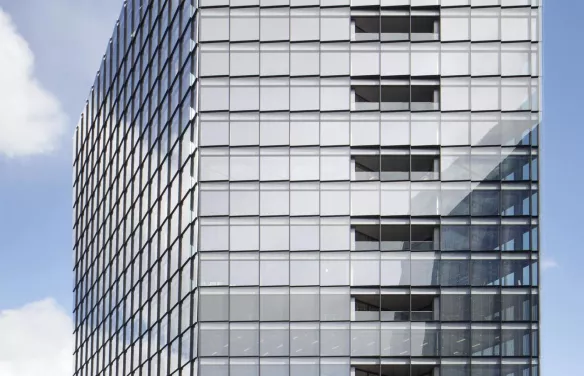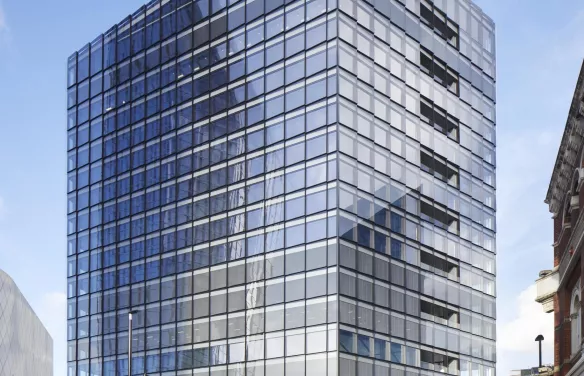Technically speaking, Arbor’s façade has been extremely successful and delivers exceptional performance.
In the heart of London, "Bankside Yards" will be the UK's first large mixed-use development with no use of fossil fuels and with net-zero CO2-emission from day one. "Arbor", designed by PLP Architecture (London), is the first finished of eight planned buildings here amidst 3.3 hectares of public space, eight public squares, 14 historic rail-road arches and new retail and cultural spaces. The architects' concept for the 19-storey design was to create a sustainable and ultra-modern office building that promotes meaningful and productive interaction between people rather than just providing space to work. Integrated into the intelligent "Energy Sharing Network" of the new district and supplied with renewable energy, it has achieved the "BREEAM Excellent" certificate - WELL Gold is on target. The intelligent closed cavity façade for maximum daylight transmission, which Scheldebouw (Netherlands) realised with iplus 1.0 thermal insulation glass and extraordinary bright impact panes from AGC Interpane Architectural Glass, significantly contributes to this.

PLP designed the building with a clear focus on holistic sustainability and the well-being of the building's users: high ceilings and the floor-to-ceiling, three-metre-wide glazing of the closed cavity façade (CCF) provide plenty of natural daylight and open up panoramic views over the city. At street level a large glazed lobby and external plaza ensure a seamless connection with the surrounding neighbourhood. The addition of the building creates a series of public spaces designed to encourage dynamic interaction between building users, visitors and residents. The first public space leads through the elevated arches of the historic railway, next to the glazed and partly 14 metre high lobby as a transition into the interior of the Arbor. Here, escalators transport building users to a terrace-like interior landscape that can be used as both a work and social space. On the two levels above, there are communal work areas, a café and double-height event rooms behind dramatic six-metre-high glazing, which are designed to promote productivity and encourage "big thinking" with an exceptional amount of natural daylight.

The Closed Cavity façade realised by Scheldebouw (Netherlands) is a central part of the concept, which aims to utilise daylight and achieve excellent energy efficiency: The inner shell is formed by a double thermal insulation glazing, the outer skin by a thin laminated safety glass unit. In order to achieve the highest possible daylight transmission, colour neutrality and excellent thermal insulation of the large-format glazing elements, AGC Interpane Architectural Glass combined around 15,000 m² of highly efficient iplus 1.0 thermal insulation glazing in all required dimensions on the inside of the façade with laminated safety glass impact panes made of low-iron float glass "Clearvision", which are intended to transmit maximum daylight into the building. In all other parts of the façade, the low-iron AGC base glass "Clearvision" is used, for example in the partially screen-printed parapet glazing.


Technically speaking, Arbor’s façade has been extremely successful and delivers exceptional performance. However, I’d say where it really excels is in the experiential effect it creates for anyone in the building. The large 3-by-3-metre glazed panels bring in huge amounts of natural light and frame incredible views over London on all sides of Arbor. They’re of such a scale and clarity that you can’t be in the building and not feel the ‘wow-effect’. Over time, we will be able to see this having a notably positive effect on occupants’ health, wellbeing and creativity.
As part of the Bankside Yards masterplan, Arbor is integrated into a fifth-generation low-temperature energy network that spans a total area of 5.5 hectares. This is the term used to describe heating networks at a very low temperature level, which are connected to decentralised heat pumps in buildings and raised to the required flow temperature of the heating system. The term comes from the English term "5th generation district heating and cooling" (5GDHC). This network is utilised by the entire connected infrastructure in Bankside Yards and leads to greater energy efficiency and immense CO2 savings. Arbor is also carbon neutral in operation, powered by electricity from re-newable sources, despite the extensive flexible workspace of almost 223,000 sqft. (around 21,000 square metres) across 19 floors. Arbor recently achieved the demanding "EPC A" rating (Energy Performance Certificate) for its outstanding energy efficiency. Compared to standard buildings in this class, it saves around 30 per cent energy, thanks in part to real-time monitoring via smart metering and sensor-controlled LED lighting to avoid unnecessary use. State-of-the-art technologies also enabled the "WiredScore Platinum" certificate for the building's digital connectivity. Employees and the public are also to contribute to the CO2 neutrality of the new neighbourhood and will find 330 new bicycle parking spaces and a connected bicycle maintenance station.

